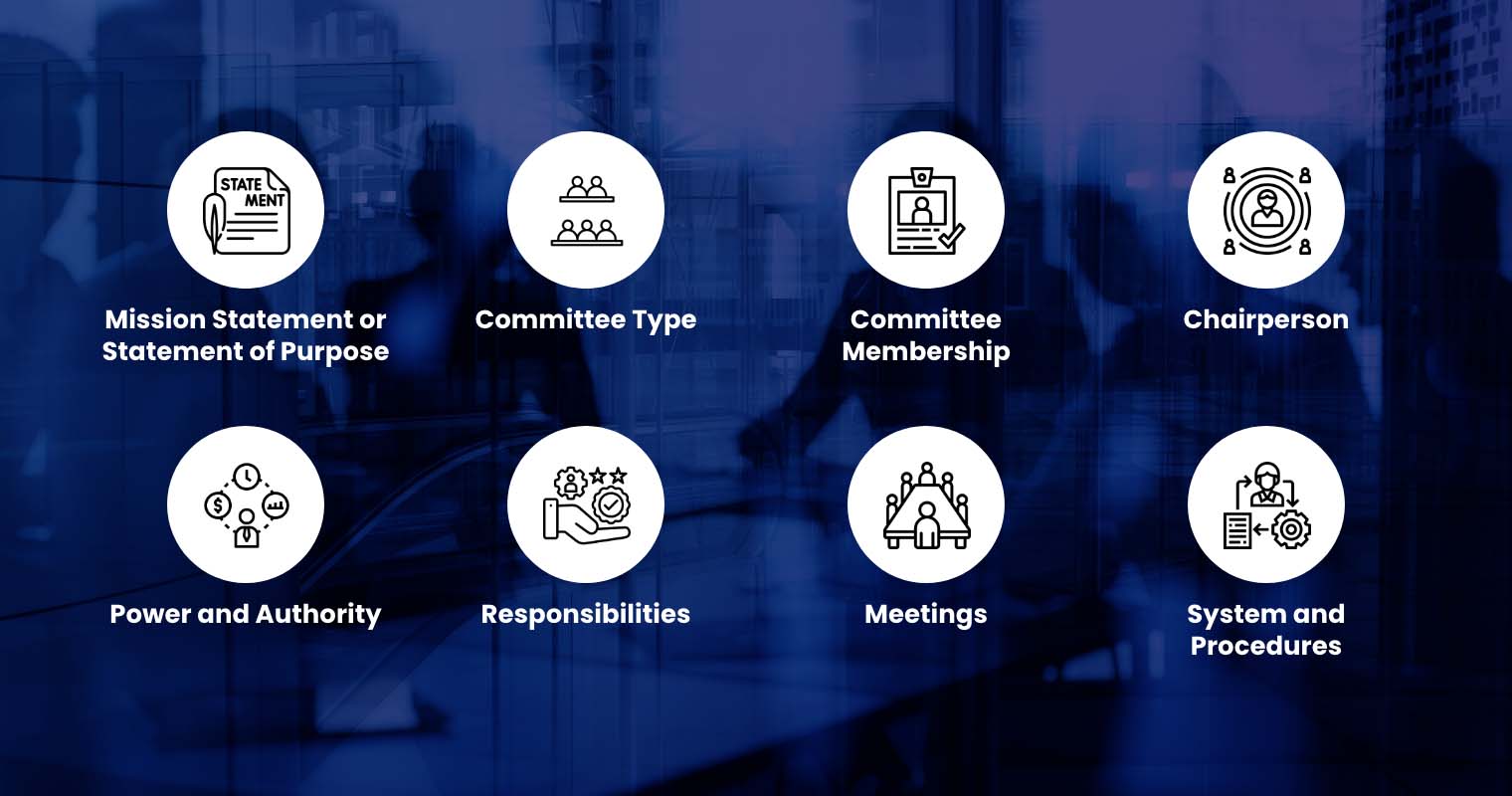Since the start of civilization, societies have been governed by sets of roles and rules. From the leader down to their advisors and bureaus have observed these directives. Fast forward to the present, these sets of rules are still applied to various organizational structures, including boards and committees.
Different committees vary in purposes and needs, thus requiring different constitutions. To ensure that board committees function well, these agreed-upon rules must be written down and circulated properly. A committee charter is an official document that defines the purpose, authority, responsibility, and limitations of a certain committee.
When establishing committees, it is imperative to also prepare their respective charters. This can prevent committees to underperform or run wild, and promote better accountability and governance. Explore below the key components to include and useful tips when writing a committee charter.
What is a committee charter?
A board committee charter is a vital document that sets out the objectives, authority, and processes of a particular committee. It serves as a guide for how the committee operates and ensures that all members are aligned with the committee’s purpose. A well-written charter can help ensure that all committee members are on the same page and working towards a common goal.
While a committee charter is distinct from a board charter, both documents play crucial roles in ensuring board and committee members function effectively.
Are charters required for each committee?
Generally, charters are not mandatory for each committee but are highly recommended as they provide a means to manage the functions and responsibilities of the committee. Most private companies, however, might require a committee charter for legal purposes. Nonprofits, on the other hand, might only need an authorized document that includes the committee’s authority, scope, and policies.
What is the purpose of the committee charter?
With the purpose, scope, and responsibilities all outlined in the charter, it helps to establish clear lines of communication and awareness. This can help prevent confusion or misunderstandings on the committee’s role throughout the organization.
Committee charters also can be a point of reference for disputes since these document all the agreed-upon responsibilities and processes concerning the specific committee. Additionally, the charter can be used as a tool for evaluating the committee’s performance and determining whether any changes or improvements are needed.
Developing the Committee Charter
Developing a committee charter is essential in establishing good governance practices within the organization. When creating one, it is crucial that the board discusses and formulates the charter accordingly. Most organizations may have a similar process in creating committee charters with their board charter. The key stages include:
- Governance personnel meetings — This involves the chair, CEO, the company secretary, and the assigned committee members collaborating in formulating the charter. Through these meetings, they can determine the committee’s purpose and roles that align with the organization’s objectives and values.
- Initial draft of the charter — This includes preparing all the material and information needed to formulate the committee charter.
- Board/Committee workshop — This is where members will facilitate a discussion and review of the preliminary charter draft. Members can ask questions and suggest revisions to ensure that the final version reflects the members’ opinions.
- Final approval — The charter will be presented to the board for approval. The board should ensure that the document is relevant and represents the organization’s governance policies.
- Annual review — The committee and the board must review the charter annually to adhere to the changes or updates.
What are the key elements of a committee charter?

Being the primary document of the committee, the charter must be clear and complete so everyone can utilize it accordingly. In essence, it should accommodate the core function and processes of the committee, including:
Mission Statement or Statement of Purpose
The first section of the charter, the mission statement describes the committee’s purpose to the board and the organization. It should answer the question of why the committee was created and how it will enable the organization to achieve its goals.
A well-crafted mission statement sets the tone for the entire charter. It provides a framework to align activities and decision-making with the overall goals of the organization. It must be clear and concise — to easily be understood by the members and other committees.
Committee Type
In this section, the nature of the committee should be specified — whether it is a standing or adhoc committee. A standing committee operates on an ongoing basis whereas an adhoc committee exists only for a certain period of time to address a specific issue or project.
Identifying the type of committee can help manage the expectations of the members and stakeholders. In addition, the charter should outline the focus areas for a standing committee.
Committee Membership
After crafting a mission statement, the charter should outline the composition of the committee as well as the process of selecting members. This includes the committee size requirements, nomination procedures, and rotation requirements for members.
The following descriptions should be indicated in this part of the charter:
- Committee’s term limits
- Appointment procedures
- Selection of the committee chair and co-chair
- Granting of voting privileges to committee members
- The number of members prescribed to serve
- Relationship of the committee to the board
Furthermore, this section can serve to address termination procedures. It should explicitly state under what circumstances a member can be removed from the committee and who holds the authority to initiate this process. For other organizations, the termination procedures have a separate section in the charter.
Chairperson
The committee charter must clearly outline the process for selecting the chairperson. If the committee members elect the chairperson, the process for doing so should be detailed in the charter. It should also include the responsibilities of the chairperson — its role and authority within the committee.
This section should include details on how these positions are elected and any term limits for serving as chairperson. Additionally, the charter should state the role of the vice-chair or co-chair in supporting the chairperson and taking on any responsibilities in their absence.
Power and Authority
The authority section is crucial in defining the parameters within which the committee can operate. It should outline the committee’s authority, scope, and limitations on its decision-making power. The section should also provide guidance on how the committee will make decisions and how any disputes will be resolved.
It should also detail the degree of autonomy the committee has. Depending on the purpose of the committee, the board can grant a significant level of authority, whereas others may be restricted.
Lastly, it should also include the limitations of the committee’s authority — including what it is not authorized to do. By clearly defining the limits of its authority, the board can ensure that the committee operates without exceeding its mandate.
Responsibilities
Being the bulk of the charter, the responsibilities section outlines the roles and specific duties of each committee member. This section specifies the expected level of participation from every member, including attendance at meetings, contributions to committee discussions, and completion of assigned tasks within a certain timeframe. It also identifies specific information on chairing important meetings, discussion of board reports, and what materials and information are expected from members.
Meetings
The section on meetings provides guidance on how the committee should approach their meetings and ensure they are conducted effectively. This section includes specific details such as the frequency of meetings, attendance requirements, constituting a quorum, and how meeting minutes will be recorded. Any special protocols related to handling meeting disruptions should be addressed in this section.
System and Procedures
Standard procedures should be established to ensure that each member understands their specific tasks and roles. This section of the charter should cover the committee’s reporting practices, including how frequently reports will be submitted and to whom they will be delivered. It should also outline the designation of executive or administrative assistants and the level of access to sensitive information granted to assistants.
Templates for a Board Committee Charter
When crafting your committee charter, it is important to also further check examples from other organizations within your industry. Here are a few samples.
Disclaimer: All charters are publicly available on their respective websites and are not affiliated with Convene.
Private Companies and Financial Institutions
- Corporate Governance & Nominating Committee Charter (Emerson Electric Co.)
- Audit Committee Charter (Concentrix)
- Compensation and Human Capital Committee Charter (Bank of America)
- Finance Committee Charter (The Coca-Cola Company)
- Cyber and Information Security Committee Charter (Aboitiz Equity Ventures Inc.)
Government
- Federal Advisory Committee Charters (US General Services Administration)
- Audit & Risk Committee Charter (Monash Council (City of Monash, Victoria))
- Scientific Integrity Committee Charter (US Environmental Protection Agency)
Nonprofits
- Executive Committee Charter (Sloan Foundation)
- Governance Charter (Western Australian Cricket Association)
Effective Tips for Writing a Compelling Committee Charter

A well-crafted charter is one step to setting your committee to achieve your organizational goals. Here are some tips to help you create your own charter.
- Be clear and specific — To ensure effective communication and efficiency, it is essential to write a committee charter using clear and simple language that all members can understand. The charter should provide detailed descriptions of the committee’s tasks to prevent confusion.
- Be mindful of the bylaws — For compliance, it’s crucial to consider the bylaws when creating the charter. While the board has the authority to create these rules, they must ensure that they don’t contradict the bylaws.
- Be transparent — To promote transparency and accountability, it’s important to clearly outline all the duties, responsibilities, and procedures of the committee. This will enable every member to have a clear understanding of their roles and responsibilities and how to conduct themselves in any circumstance.
- Be flexible — In writing your charter, be open to adjustments in the committee structure and governance trends. The committee and the charter should be adaptable to changes in the organization’s direction, membership, or needs. Review your charters annually and revise accordingly.
Create Strong Committee Charters with Board Software
Writing committee charters can be difficult with all the processes involved. Fret not, because a board portal can help! Convene is the trusted board management software for boards and committees across industries. Conveniently create charters with Convene’s advanced features and capabilities. You can do the following and more:
- Discuss and collaborate during meetings
- Review and approve instantly using digital tools
- Store, retrieve, and update your charters in a centralized hub
- Protect policies and full charters with role-based permission controls and audit trails
Discover more about Convene and how it can help your board and committees! Contact us now for a free demo.
Audrey is a Content Marketing Specialist at Convene, in charge of managing the production of quality content on the company’s website. A communication major keen on marketing, Audrey has been constantly seeking approaches to create tailored content—may it be about governance, digitalization, boards, or meetings—fit for the stakeholders. When not strategizing on the next ebook to produce, Audrey finds solitude in reading make-you-ugly-cry novels and listening to self-improvement podcasts.











